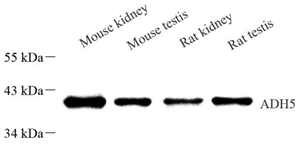| Reactivity: | M,R |
| Applications: | WB |
| Host Species: | Rabbit |
| Clonality: | Polyclonal |
| Full Name: | ADH5 rabbit polyclonal antibody |
Gene Name: | Alcohol dehydrogenase class-3 |
Synonyms: | Alcohol dehydrogenase 2, Alcohol dehydrogenase 5, Alcohol dehydrogenase B2, ADH-B2, Alcohol dehydrogenase class-III, FALDH, FDH, GSH-FDH, Adh5, Adh-2, Adh2 |
Immunogen: | KLH conjugated Synthetic peptide corresponding to Mouse ADH5 |
Isotype: | IgG |
Purity: | Affinity purification |
Predicted MW. | 40 kDa |
Observed MW. | 40 kDa |
Uniprot ID: | P28474, P12711 |
Product Usage Information
Applications | Species | Dilution | Positive Sample |
WB | Mouse, Rat | 1: 1000-1: 2000 | kidney, testis |
Background
The alcohol dehydrogenase family of proteins metabolize a wide variety of substrates, including retinol, hydroxysteroids, ethanol, aliphatic alcohols and lipid peroxidation products. ADH5 (alcohol dehydrogenase 5 (class III)), also known as FDH (formaldehyde dehydrogenase), ADHX, ADH-3 or GSNOR, is a 374 amino acid cytoplasmic protein that belongs to the class III subfamily of alcohol dehydrogenases. Expressed ubiquitously, ADH5 uses iron as a cofactor to catalytically oxidize both long-chain primary alcohols and S-hydroxymethyl-glutathione, a product formed spontaneously between formaldehyde and glutathione. ADH5 exists as a homodimer and, via its ability to oxidize S-hydroxymethyl-glutathione and, thus, eliminate formaldehyde, functions as an important component of cellular metabolism.
Images
 | Western blot analysis of ADH5 (GB112624) at dilution of 1: 1000 |
Storage
| Storage | Store at -20°C for one year. Avoid repeated freeze/thaw cycles. |
| Storage Buffer | PBS with 0.02%sodium azide,100 μg/ml BSA and 50% glycerol. |



